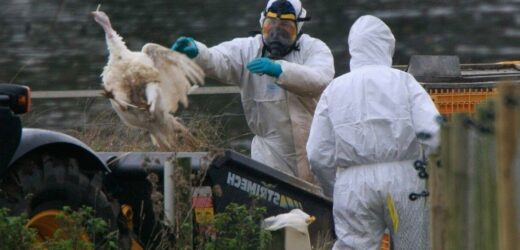What is Bird Flu?
We use your sign-up to provide content in ways you’ve consented to and to improve our understanding of you. This may include adverts from us and 3rd parties based on our understanding. You can unsubscribe at any time. More info
An expert has warned that a “really concerning” outbreak of bird flu could “herald the next pandemic” if just two more mutations occur. Dr Justine Butler, head of research at Viva!, has raised the alarm over the UK’s worst-ever outbreak of bird flu, which has already killed millions of birds. She warned it could cause serious problems if the virus starts jumping from mammal to mammal.
It comes after reports emerged that the virus has jumped from birds to mammals, specifically foxes and otters, in the UK.
She told Express.co.uk: “For some years now, bird flu has been jumping from birds from all sorts of different mammals, including whales even.”
In fact, there have been 200 cases recorded in mammals, including grizzly bears, mink, dolphins and seals.
However, while she said this jump is not an immediate threat, Dr Butler suggested that the outbreak of the virus at a Spanish mink farm could indicate that something more serious may be on the horizon.
Investigations found evidence of mink-to-mink transmission that occurred at a farm in the Galicia region of Spain, although staff working there did not test positive for the virus.


Dr Butler said that what happened at the Spanish mink farm is “very concerning”.
She said: “They think the virus has been tainted to make it more easily transmissible between mammals. That is a concern.
“Once it spreads between one group of mammals, there is a possibility that it will be transmitted to humans and that could herald the next pandemic, which is really concerning. Just like Covid is easily spread in the air and there are different variants with some more transmissible than others. It is exactly the same with bird flu.”
But that does not mean that the virus’ presence in British foxes and otters is not something to be worried about.
Dr Butler said: “Experts have said the virus is on the march, and that figures all kind of things. It could be only two or three mutations away from being able to transmissible between humans…Mutations occur randomly and if they offer the virus and that vantage then it will thrive.”

According to the WHO, there have been almost 870 cases of human infection with the avian influenza H5N1 virus reported from 21 countries over the last 20 years. Up to 457 of these cases were fatal. This indicates a relatively high case fatality rate in people who become infected.
Dr Butler said: “The H5N1 in this country that huge numbers of birds are infected with is a different subgroup to the one that has killed people. But nevertheless, it poses a threat.
“If you look at the number of people that have died from H5N1 across the world, most of those people caught the virus by handling infected birds. There have been a very small number of cases of human-to-human transmission among people who were caring for sick relatives.
“But generally speaking, the virus has made one jump because dead birds are absolutely riddled with the virus. There is a lot of it present. Foxes and otters have been found to be present with it because they are scavengers and they probably ate a dead bird that had the virus.
DON’T MISS
Skies over parts of UK turn ‘fiery’ red in rare sunset phenomenon [REPORT]
Missing mum search may take months as police examine all evidence [REVEAL]
Shell defends oil rig that could make it ‘billions more in profit’ [INSIGHT]

“It is a concern. But so far it has not been transmitted between foxes or otters. Those individuals have caught the virus and not passed it on so don’t have a mutation that allows the virus to spread between mammals.”
However, according to Dr Butler, thousands of animals are kept in conditions similar to that seen in the Spanish mink farm.
She said: “We have factory-farmed poultry and pigs and we are getting more of these so-called megafarms that will house tens of thousands of birds. Viva! do exposés of this, where we have gone into factory farms and people are always horrified when they see the conditions the birds are kept.
“Factory farms provide the perfect breeding ground for these viruses. They are getting bigger and bigger and more intense. The biosecurity measures are obviously failing. Migratory viruses bring the viruses in and then it spreads.
“We haven’t learned anything about how to treat animals, and wild animals encouraging live animals, despite the pandemic. We need to have a new way of thinking and the way that we are going, it is jeopardising public health on a global scale.”

This comes as the World Health Organisation warns that the world “must prepare” for bird flu, which could soon stop posing a low risk to humans.
WHO Director-General Tedros Adhanom Ghebreyesus said on Wednesday said that “for the moment, the WHO assesses the risk to humans as low”, adding that there has only been “rare and non-sustained” transmission to and between humans.
But he added: “We cannot assume that will remain the case and we must prepare for any change in the status quo.”
The WHO chief urged countries to ramp up surveillance of areas where humans and animals interact. The organisation is working to ensure that supplies of vaccines and antivirals are made available if the situation worsens. Mr Ghebreyesus added that the WHO is in discussions with manufacturers.
Dr Meera Chand, incident director for avian influenza at the UK Health and Security Agency, said: “Latest evidence suggests that the avian influenza viruses currently circulating in birds do not spread easily to people. We remain vigilant for any evidence of changing risk.”
Express has reached out to DEFRA for comment.
Source: Read Full Article


